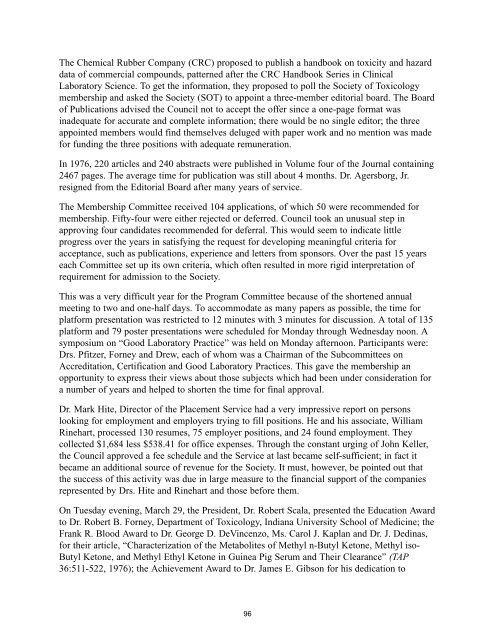SOCIETY O. TOXICOLOGY HISTORY - Society of Toxicology
SOCIETY O. TOXICOLOGY HISTORY - Society of Toxicology
SOCIETY O. TOXICOLOGY HISTORY - Society of Toxicology
Create successful ePaper yourself
Turn your PDF publications into a flip-book with our unique Google optimized e-Paper software.
The Chemical Rubber Company (CRC) proposed to publish a handbook on toxicity and hazard<br />
data <strong>of</strong> commercial compounds, patterned after the CRC Handbook Series in Clinical<br />
Laboratory Science. To get the information, they proposed to poll the <strong>Society</strong> <strong>of</strong> <strong>Toxicology</strong><br />
membership and asked the <strong>Society</strong> (SOT) to appoint a three-member editorial board. The Board<br />
<strong>of</strong> Publications advised the Council not to accept the <strong>of</strong>fer since a one-page format was<br />
inadequate for accurate and complete information; there would be no single editor; the three<br />
appointed members would find themselves deluged with paper work and no mention was made<br />
for funding the three positions with adequate remuneration.<br />
In 1976, 220 articles and 240 abstracts were published in Volume four <strong>of</strong> the Journal containing<br />
2467 pages. The average time for publication was still about 4 months. Dr. Agersborg, Jr.<br />
resigned from the Editorial Board after many years <strong>of</strong> service.<br />
The Membership Committee received 104 applications, <strong>of</strong> which 50 were recommended for<br />
membership. Fifty-four were either rejected or deferred. Council took an unusual step in<br />
approving four candidates recommended for deferral. This would seem to indicate little<br />
progress over the years in satisfying the request for developing meaningful criteria for<br />
acceptance, such as publications, experience and letters from sponsors. Over the past 15 years<br />
each Committee set up its own criteria, which <strong>of</strong>ten resulted in more rigid interpretation <strong>of</strong><br />
requirement for admission to the <strong>Society</strong>.<br />
This was a very difficult year for the Program Committee because <strong>of</strong> the shortened annual<br />
meeting to two and one-half days. To accommodate as many papers as possible, the time for<br />
platform presentation was restricted to 12 minutes with 3 minutes for discussion. A total <strong>of</strong> 135<br />
platform and 79 poster presentations were scheduled for Monday through Wednesday noon. A<br />
symposium on “Good Laboratory Practice” was held on Monday afternoon. Participants were:<br />
Drs. Pfitzer, Forney and Drew, each <strong>of</strong> whom was a Chairman <strong>of</strong> the Subcommittees on<br />
Accreditation, Certification and Good Laboratory Practices. This gave the membership an<br />
opportunity to express their views about those subjects which had been under consideration for<br />
a number <strong>of</strong> years and helped to shorten the time for final approval.<br />
Dr. Mark Hite, Director <strong>of</strong> the Placement Service had a very impressive report on persons<br />
looking for employment and employers trying to fill positions. He and his associate, William<br />
Rinehart, processed 130 resumes, 75 employer positions, and 24 found employment. They<br />
collected $1,684 less $538.41 for <strong>of</strong>fice expenses. Through the constant urging <strong>of</strong> John Keller,<br />
the Council approved a fee schedule and the Service at last became self-sufficient; in fact it<br />
became an additional source <strong>of</strong> revenue for the <strong>Society</strong>. It must, however, be pointed out that<br />
the success <strong>of</strong> this activity was due in large measure to the financial support <strong>of</strong> the companies<br />
represented by Drs. Hite and Rinehart and those before them.<br />
On Tuesday evening, March 29, the President, Dr. Robert Scala, presented the Education Award<br />
to Dr. Robert B. Forney, Department <strong>of</strong> <strong>Toxicology</strong>, Indiana University School <strong>of</strong> Medicine; the<br />
Frank R. Blood Award to Dr. George D. DeVincenzo, Ms. Carol J. Kaplan and Dr. J. Dedinas,<br />
for their article, “Characterization <strong>of</strong> the Metabolites <strong>of</strong> Methyl n-Butyl Ketone, Methyl iso-<br />
Butyl Ketone, and Methyl Ethyl Ketone in Guinea Pig Serum and Their Clearance” (TAP<br />
36:511-522, 1976); the Achievement Award to Dr. James E. Gibson for his dedication to<br />
96
















